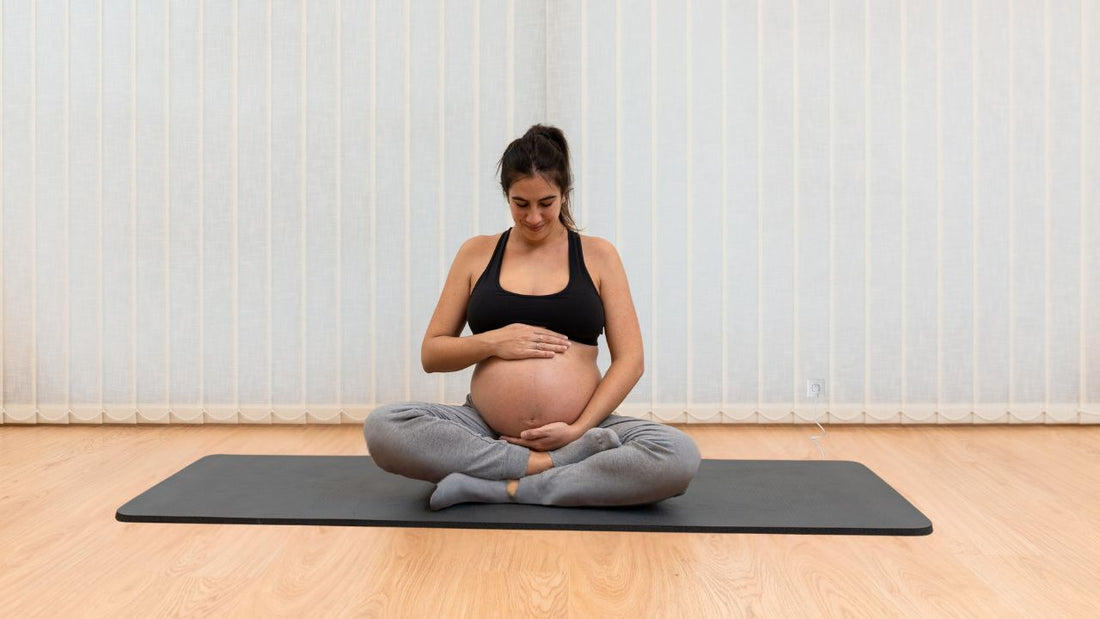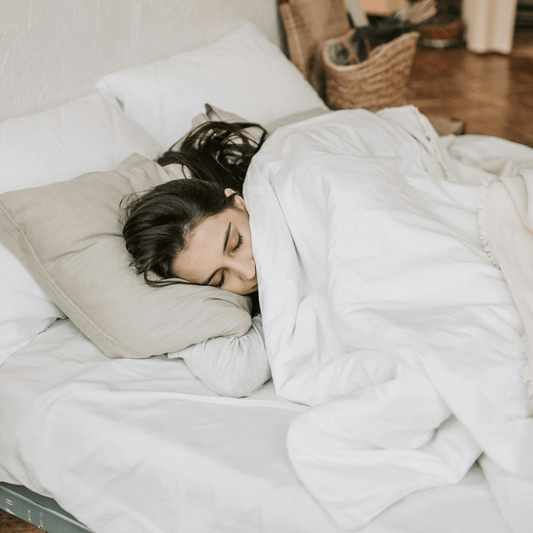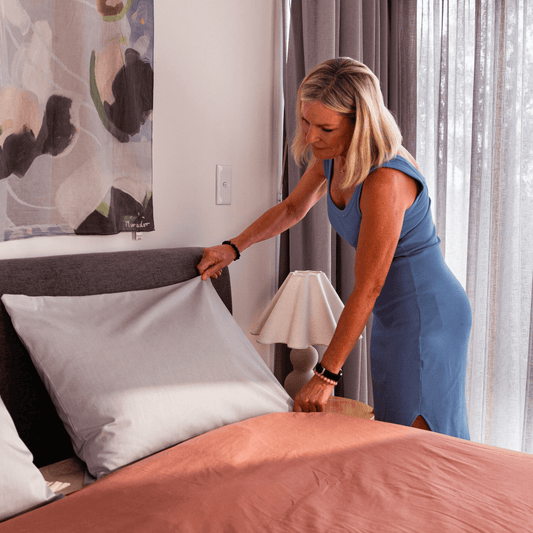
Is Grounding Really Safe for Personal Use?
How Grounding Works for People
Grounding, or earthing, is when you make direct contact with the Earth’s surface. Walking barefoot on grass, soil, or sand is the most common way, but grounding mats and sheets work indoors too.
The idea is that the Earth has a natural electrical charge, and connecting to it might help balance the body’s energy. Some people use grounding to reduce stress, improve sleep, or support overall wellness.
But is it safe for everyone? Let's take a look.
Quick Key Takeaways
- Grounding (earthing) is generally safe for most people and involves connecting the body to the Earth’s natural electrical charge.
- It can be done outdoors (walking barefoot, swimming in natural water) or indoors using grounding products.
- Reported benefits include better sleep, reduced inflammation, stress relief, and improved mood.
- Grounding is considered low-risk, but people with pacemakers, defibrillators, or medical implants should consult a doctor first.
- Those on blood-thinning medications should also seek medical advice before grounding regularly.
- Safety depends on using high-quality grounding products with proper conductivity and safe materials.
- Outdoor grounding should be done with caution—avoid unsafe terrain, sharp objects, or contaminated soil/water.
Is Grounding Safe for Pregnant Women?
We've received a lot of anecdotal evidence that grounding whilst pregnant has helped with stress, sleep and circulation.
If using grounding mats or grounding sheets, it's important to ensure they are high-quality and properly tested for electrical safety.
Pregnant women should use caution when naturally grounding. Potential risks include exposure to bacteria, pesticides, or sharp objects when walking barefoot outdoors.
See also: How Grounding Works on Babies
Is Grounding Safe for People with Chronic Conditions?
Grounding may offer benefits like reduced inflammation and stress.
But if you have a chronic condition, it’s best to check with your doctor first.
- Autoimmune Disorders (e.g., lupus, rheumatoid arthritis): Some believe grounding helps with inflammation, but those with immune system sensitivities might react differently. It’s important to monitor how your body responds.
- Heart Conditions (e.g., pacemakers, blood thinners): Since grounding may influence blood thickness and has been scientifically proven to improve blood viscosity, if you have a pacemaker or take blood thinners, start with short sessions and pay attention to any changes.
- Neurological Conditions (e.g., epilepsy, multiple sclerosis): There isn’t enough research on how grounding affects nerve function. If you have a neurological disorder, start with short sessions and pay attention to any changes.
Is Grounding Safe for People with Sensitive Skin or Allergies?
People with sensitive skin or allergies may experience irritation from grounding, especially when making direct contact with grass or soil.
If you have a history of skin reactions, it's important to be cautious.
- Outdoor Grounding Risks: Grass, dirt, and sand can contain allergens, pesticides, or bacteria that may cause itching, rashes, or flare-ups. Walking barefoot in unknown areas increases the chance of exposure.
- Grounding Products & Materials: Some grounding mats, sheets, or wristbands are made with synthetic materials or metals like silver and copper. Those with metal allergies should check product ingredients before use. Always look to use grounding products with high quality, natural materials.
- Skin Conditions (e.g., eczema, dermatitis): If your skin is already sensitive, prolonged grounding might lead to irritation whilst your body goes through a gentle detox. Typically grounding helps to reduce symptoms over time.
If you notice redness, itching, or any discomfort, stop grounding and see if a different method—like a hypoallergenic grounding mat—works better for you.
Is Grounding Safe for People with Electrical Sensitivities (EHS)?
People with electromagnetic hypersensitivity (EHS) may react differently to grounding.
Grounding may neutralize electrical charge in the body, which some believe can ease symptoms like headaches, fatigue, or brain fog.
If you have EHS, start with short barefoot grounding sessions outside or intermittent grounding inside using grounding products and see how you feel.
See also: How to test your grounding products
Is Grounding Safe for People with Metal Implants?
Grounding is a naturally supportive practice and is generally considered safe for individuals with metal implants or prosthetics. Research has not shown any harmful effects on implants from grounding.
- Joint Replacements and Surgical Implants: Grounding is a naturally supportive practice and is generally considered safe for individuals with metal implants or prosthetics. Research has not shown any harmful effects on implants from grounding.
-
Pacemakers and Electronic Implants:
For those with pacemakers or other electronic devices, using grounding mats or sheets connected to electrical outlets calls for a bit of extra care. Although electrical interference is extremely rare, consulting your doctor can provide additional reassurance.
Can Grounding Be Risky in Certain Environments?
Grounding isn’t always safe in every location. Certain environments come with risks that can outweigh the benefits.
- Urban Areas: Public spaces like sidewalks and city parks may have pollutants, pesticides, or sharp objects. Stepping on contaminated surfaces barefoot could lead to infections or injuries.
- Electrical Hazards: Being near power lines or using faulty grounding mats may expose you to unwanted electrical currents. If you’re grounding indoors, make sure the product is properly tested and safe.
- Extreme Temperatures: Cold surfaces can cause numbness or frostbite, while hot sand or pavement may burn your feet. Weather conditions should always be considered before grounding outside.
For a safer experience, choose clean, natural spaces like a backyard or a well-maintained park. If outdoor conditions aren’t ideal, a high-quality grounding mat indoors can be a better alternative.
How to Practice Grounding Safely Based on Your Needs
Grounding is safe. that's without a doubt, but for most people, some may need to take extra precautions.
- Pregnant Women: Use clean environments or grounding mats and check with a doctor first.
- Elderly Individuals: Avoid uneven surfaces to prevent falls. Sitting outside or using a grounding mat is safer.
- People with Chronic Conditions: If you have heart issues, autoimmune disorders, or neurological conditions, start slow.
- Those with Sensitive Skin or Open Wounds: Avoid dirty or rough surfaces. A clean grounding mat may be a better option.
- People with Metal Implants or Electronic Devices: If using a pacemaker or electronic implant, ensure you are using high quality products.
- Unsafe Environments: Stay away from polluted areas, electrical sources, and storms. Choose clean grass, sand, or a safe indoor mat.
If grounding causes discomfort, stop and reassess. When unsure, talk to a healthcare professional.
Frequently Asked Questions
-
Is grounding safe for everyone?
For most people, yes. However, individuals with pacemakers, defibrillators, or certain medical conditions should consult a doctor first. -
Can grounding interfere with pacemakers or implants?
Yes, electrical grounding may interact with medical devices, so it’s best to seek medical advice before trying it. -
Are there side effects of grounding?
Most users experience no side effects, though some report mild tingling, fatigue, or detox-like symptoms at first. -
Can grounding help with inflammation?
Studies suggest grounding may reduce inflammation by balancing the body’s electrical state. -
Is grounding safe for children?
Yes, children can safely enjoy grounding outdoors, but ensure the environment is safe (no sharp objects, toxins, or extreme weather). -
Can grounding help with sleep issues?
Many users report improved sleep quality and reduced insomnia from consistent grounding practices. -
Do grounding mats really work?
Yes, when properly made with conductive materials and connected to the earth, grounding mats can mimic outdoor grounding. -
Is outdoor grounding better than indoor grounding?
Both have benefits. Outdoor grounding provides a natural connection, while indoor products offer convenience. -
Can grounding be harmful if done too much?
There’s no strong evidence of harm, but people with medical conditions should avoid excessive use without guidance. -
Is grounding safe during thunderstorms?
No. Avoid grounding outdoors during storms to prevent electrical risks. -
Can grounding boost mood and reduce stress?
Yes, many users report feeling calmer and less stressed after grounding. -
What surfaces are best for grounding?
Grass, soil, sand, and natural water are highly conductive. Asphalt and wood are less effective. -
Can grounding products cause skin irritation?
Low-quality products may, so always choose well-made, hypoallergenic options. -
Is grounding safe while pregnant?
Generally safe, but pregnant women should consult their healthcare provider before using grounding devices. -
Do grounding sheets and mats need to be cleaned?
Yes, regular cleaning helps maintain conductivity and hygiene.
References
Chevalier, G., Sinatra, S. T., Oschman, J. L., & Delany, R. M. (2013). Earthing (grounding) the human body reduces blood viscosity—a major factor in cardiovascular disease. Journal of Alternative and Complementary Medicine, 19(2), 102–110. https://doi.org/10.1089/acm.2011.0820
Lin, C.-H., Tseng, S.-T., Chuang, Y.-C., Kuo, C.-E., & Chen, N.-C. (2022). Grounding the body improves sleep quality in patients with mild Alzheimer’s disease: A pilot study. Healthcare, 10(3), 581. https://doi.org/10.3390/healthcare10030581
Oschman, J. L., Chevalier, G., & Brown, R. (2015). The effects of grounding (earthing) on inflammation, the immune response, wound healing, and prevention and treatment of chronic inflammatory and autoimmune diseases. Journal of Inflammation Research, 8, 83–96. https://doi.org/10.2147/JIR.S69656
Park, H.-J., Jeong, W., Yu, H. J., Ye, M., Hong, Y., Kim, M., Kim, J. Y., & Shim, I. (2023). The effect of earthing mat on stress-induced anxiety-like behavior and neuroendocrine changes in the rat. Biomedicines, 11(1), 57. https://doi.org/10.3390/biomedicines11010057
Sokal, K., & Sokal, P. (2011). Earthing the human body influences physiologic processes. Journal of Alternative and Complementary Medicine, 17(4), 301–308. https://doi.org/10.1089/acm.2010.0687
Ye, M., Yu, H. J., Park, H.-J., Jeong, W., & Shim, I. (2024). Effect of earthing mats on sleep quality in rats. International Journal of Molecular Sciences, 25(18), 9791. https://doi.org/10.3390/ijms25189791







